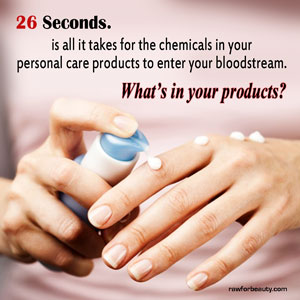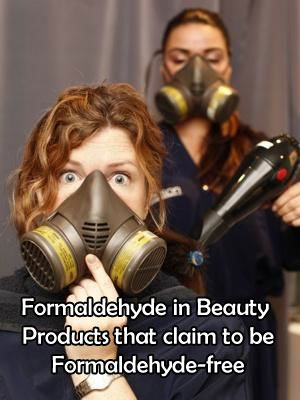Dirty dozen toxic chemicals in cosmetics and skincare products
Most cosmetics and skincare products have tons of toxic chemicals and harsh additives that have been linked to a wide range of chronic diseases. In fact, a recent study by University of Berkeley in California shows that many popular lipsticks have high levels of aluminum, arsenic, lead, chromium and other heavy metals in them. Disturbingly, according to researchers, even the average use of lipsticks can result in excessive exposure to chromium that is linked to stomach tumors.
Here are the top 12 toxic chemicals commonly used in cosmetics and skincare products:
1. Anything ending with ‘Siloxanes or methicone”:
Many cosmetics and skincare products including deodorants, moisturizers, hair sprays, mousses, gels and defoamers are filled with toxic chemicals including siloxanes or methicone. These chemicals are known to be endocrine disrupters, toxic to the environment and cause a wide range of health issues including cancer, infertility and allergies.
Siloxanes are a type of silicone commonly used in breast augmentation and implants. Silicone implants are prone to leakage of cancer-causing neurotoxic chemicals. Although, the cosmetic industry promotes saline implants as a safer alternative to silicones, studies have shown that Saline implants could be as dangerous as silicone.
2. Diethanolamine (DEA), quaternium-15 (MEA and TEA) related chemicals:
These toxic chemicals are used in many skincare products, cosmetics and foaming products including moisturizers and shampoos. In fact, an independent test by the Center for Environmental Health revealed that 98 different shampoos, soaps and personal care products sold by big retailers such as WalMart, Target, Trader Joe’s, Pharmaca, Kohl’s, and Babies R Us contain cancer-causing chemicals that violates the California Law: http://www.seattleorganicrestaurants.com/vegan-whole-food/cancer-causing-chemical-DEA-found-in-100-shampoos-personal-care-haircare-products.php
In addition, both DEA and MEA are hormone disrupting chemicals linked to cancer. “Repeated skin applications of DEA-based detergents resulted in a major increase in the incidence of two cancers - liver and kidney cancers", says Dr. Samuel Epstein, Professor of Environmental Health at the University of Illinois.
3. BHA (butylated hydroxyanisole) and BHT (butylated hydroxytoluene):
BHA and BHT are both common chemicals used as a preservative in moisturizers and cosmetics. Both chemicals are known to be endocrine disruptors and have been linked to cancer, skin allergies, and liver, thyroid and kidney toxicity.
4. Mineral Oil, Paraffin, and Petrolatum based products:
Petroleum based products are cheap and therefore heavily used in cosmetics, hair products like hair spray and heat protestants and skincare products. Although there are no regulations in US and Canada to prohibit the use of these chemicals, the European Union has put numerous grades of petrolatum on a list of dangerous substances linked to cancer.
In fact, a 2000 study published in the journal of Pediatrics shows that extremely low birth weight infants who received topical petrolatum ointment for skin care were more likely to develop systemic candidiasis (moist place for fungi to grow): http://www.seattleorganicrestaurants.com/vegan-whole-food/dangers-of-petrolatum-isopropyl-myristate-sorbitan-monooleate-PEG-methylparaben-in-skin-care-products-silvadene.php

5. Paraben based products including propylparaben , Phenoxyethanol , Methylparaben, Benzyl Benzoate, and Benzyl Salicylate:
The cosmetic industry could not care less that many studies have directly linked Paraben based products to breast cancer and disrupting body's endocrine system. As a result, different derivatives of Parabens are commonly used in cosmetics, skin care products, sunscreens, deodorants or antiperspirants. In fact, 99% of breast cancer tissues have alarming level of Parabens.
6. Sodium laurel or lauryl sulfate (SLS), also known as sodium laureth sulfate (SLES):
There are more than 16,000 studies that indicate the toxicity of both SLS and SLES in consumer products including toothpastes, shampoos, hair conditioners, soaps, facial cleanser and deodorants. SLS and SLES based products combined with other chemicals can also become "nitrosamine" – a known carcinogen.
SLS and SLES are cancer-causing chemicals that have been linked to organ toxicity, neurotoxicity, depression, asthma, eye irritation, diarrhea and even death.
7. Propylene Glycol (PEG) and Polyoxyl 40 Stearate (listed as PEG - 40 Stearate):
PEG is used as filler in many personal care products including shampoos, conditioners and soaps and even burn creams including silvadene. Propylene Glycol (PEG) has been linked to impaired immune system, damages to central nervous system, cancer, developmental and reproductive toxicity, organ toxicity, and skin irritation.
Studies also show that Polyoxyl 40 Stearate (listed as PEG - 40 Stearate) can contain harmful impurities like Ethylene Oxide, known to increase the incidences of uterine, brain, or breast cancers, and leukemia. In fact, according to researchers, patients suffering from severe burns who were treated with PEG-based antimicrobial cream end up with kidney toxicity: http://www.seattleorganicrestaurants.com/vegan-whole-food/ingredients-in-burn-creams-silvadene-silver-sulfadiazine.php
8.Synthetic fragrance includingPhthalates lead compounds, Parfum and Dibutyl Phthalate (used in nail care products):
Most shampoos, skin care products, children products, deodorants and sunscreens have synthetic fragrance including phthalates that have been linked to lower immune system, damages to central nervous system, headaches, rashes, hyperactivity, depression, dizziness, allergies, vomiting and failure in productive system.
Phthalates lead compounds are commonly used in skincare products since their oily texture make skin feel soft and increase the ability of the lotion to penetrate deep inside the skin. In labs, animals that were exposed to Phthalates have had developmental, neurological and reproductive failure. According to Proposition 65 in state of California, derivatives of Phthalates including butyl ester, DBP, BBP, DEP,benzenedicarboxylic acid are banned in toys and baby products.
9. Formaldehyde-releasing preservatives including DMDM hydantoin, diazolidinyl urea, imidazolidinyl urea, methenamine and quarternium-15:

Formaldehyde-releasing preservatives are commonly used in straightening hair products (including Japanese and Brazilian blowouts), fertilizers, bleaching agents, food preservatives and personal care products like baby shampoos and soaps. Be aware of straightening hair relaxers that claim to be Formaldehyde-free. According to a report by OSHA and Environmental Working Group, different hair straightening brands that claim to be Formaldehyde-free, natural or organic have chemicals or raw ingredients that either break down to formaldehyde or release formaldehyde into the air when they are heated. Here is the OSHA report and brands that claim to be Formaldehyde-free, although they all have ingredients or chemicals that release the toxic gas: http://www.ewg.org/hair-straighteners/our-report/hair-straighteners-that-hide-formaldehyde/
Research shows that formaldehyde can damage human cell and long term exposure to formaldehyde can lead to leukemia and cancer, and short term exposure can cause watery or burning eyes, asthma, headaches, skin irritation, and nausea.
10. p-phenylenediamine (Coal tar dyes), Toluene, Hydroquinone and Phenol carbolic acid:
p-phenylenediamine and Coal tar dyes listed as “CI” are used in hair dyes and hair products including colours. p-phenylenediamine and Coal tar dyes are neurotoxin linked to asthma, cancer and ADD and ADHD.
Toluene made from petroleum and coal tar is found in nail polishers, synthetic fragrance and paint thinners. Toluene is so toxic that’s banned by the entire European Union and has been linked to organ toxicity and anemia.
Hydroquinone banned in UK, Asia, Japan and Australia is another chemical widely used in skincare products and anti-aging creams. Hydroquinone is a neurotoxin and cancer-causing carcinogen linked to organ failure and severe allergies.
Phenol carbolic acid used in skin lotions and beauty creams has been linked to paralysis, convulsions, coma, and even death from respiratory failure.
11. Oxybenzone and OMC, known as Octylmethoxycinnamate and Ureas:
Both Oxybenzone and OMC are endocrine disrupters used in most skincare products and 90% of sunscreens. Amazingly these two chemicals used in sunscreens are known to be most toxic when exposed to sunshine.
Ureas and its derivatives inclduing diazolidinyl urea, imidazolidinyl urea, or DMDM hydantoin and sodium hydroxymethylglycinate are known to release toxic Formaldehyde.
12. Triclosan and Dioxane:
Triclosan is endocrine disrupter widely used in antibacterial cosmetics and skincare products including antiperspirants, toothpastes and cleansers. According to researchers at University of California Davis, Triclosan impairs muscle function and skeletal muscle contractility. The leading author of the study, Isaac Pessah says that “Triclosan is found in virtually everyone’s home and is pervasive in the environment. These findings provide strong evidence that the chemical is of concern to both human and environmental health.”
Dioxane is a by-product of ethylene oxide commonly used in many personal care products and shampoos. Dioxane has been linked to cancer, brain damage, damages to central nervous system and kidneys and liver problems.
Sources:
http://www.justbeautify.com/dangerous-ingredients
http://www.joyoushealth.ca/blog/2011/04/23/12-dirty-chemicals-in-your-personal-care-products/



